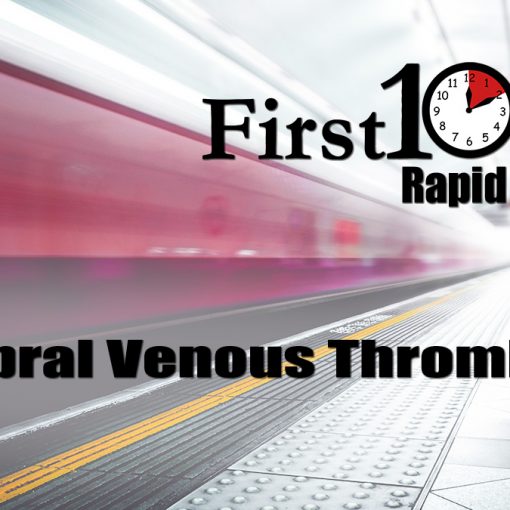In the Rapid Review series I briefly review the key points of a clinical review paper. The topic: anti-NMDA receptor encephalitis
The paper: Lasoff D, Vilke G, Nordstrom K, Wilson M. Psychiatric Emergencies for Clinicians: Detection and Management of Anti-N-Methyl-D-Asparate Receptor Encephalitis. The Journal of emergency medicine. 51(5):561-563. 2016. PMID: 27431869
What is it?
This is an autoimmune encephalitis caused by antibodies that are directed at the NMDA receptor.
How common is it?
Although rare, it is thought to be more common than herpes encephalitis, so it should definitely be on your radar.
What are the symptoms?
No finding on history or physical is specific for the disease. It seems follows a general pattern:
- Viral-like prodrome: fever, fatigue, headaches, nausea and vomiting
- Psychiatric symptoms: hallucinations, depression, and paranoia
- Neurologic symptoms: movement disorders, speech difficulties, seizures, and potentially coma
- Autonomic instability
That being said, the disease has only recently been described, and we could be missing patients with different presentations, so we shouldn’t be surprised if this symptom complex is adjusted with time.
How do I test for it?
Imaging is not helpful in making the diagnosis. The test of choice is a lumbar puncture, specifically looking for an elevated anti-NMDA antibody titer.
What is the treatment?
Emergency department management is supportive, focusing on control of psychosis, seizures, and autonomic instability. Empiric treatment for meningitis and herpes encephalitis should also be started, as the results of definitive testing will take a while. Ultimately, the patient will require IVIG, steroids, and plasma exchange.
What is the prognosis?
When diagnosed and treated, the majority of patients will improve, but up to 20% will be left with significant neurologic deficits, and mortality is still 4-5%.
Trivia
The syndrome was initially described in healthy young females with teratomas and was thought to be a paraneoplastic syndrome, but we now know that it can be present without a tumor.
Want to hear about anti-NMDA receptor encephalitis from the patient’s perspective? Check out the brilliant book, “Brain on Fire: My Month of Madness” by Susannah Cahalan.
You can find more of these Rapid Review posts here.
Morgenstern, J. Rapid Review: anti-NMDA receptor encephalitis, First10EM, January 16, 2017. Available at:
https://doi.org/10.51684/FIRS.3850






2 thoughts on “Rapid Review: anti-NMDA receptor encephalitis”
Thanks for shining a light on this! We do see it maybe once every one- or two years.
So AIE (Autoimmune encephalitis) should be on the list of things to think about – however, the tests are still very expensive, and the number needed to test is quite low
According to uptodate 2018 the current criteria are:
Subacute onset (rapid progression of 5 white blood cells per mm3)
•EEG with epileptic or slow-wave activity involving the temporal lobes
●Reasonable exclusion of alternative causes.
I would personally recommend doing normal lumbar puncture tests (along with MRI, EEG etc), and saving some samples for later testing (you can always treat before testing for the specific antigens, waiting for the rest of the paraclinical tests to come in).
If tests came back without suspicion of more common causes (HSV encephalitis, meningo-encephalitis, metabolic encephalitis, wernickes encephalopathy etc), and the pre-test probability would be with high suspicion (young age, woman, no chronic psychiatric history) in my oppinion the scenario would be beyond the treatment threshold for IVIG (as it is largely unharmfull), and in my oppinion a first dose of IVIG would be wise to do (testing for contraindications beforehand of course)
All the best
Peter, Emergency medicine / neurology, Denmark/Sweden
Uptodate*
Subacute onset (rapid progression of 5 white blood cells per mm3)
•EEG with epileptic or slow-wave activity involving the temporal lobes
●Reasonable exclusion of alternative causes.